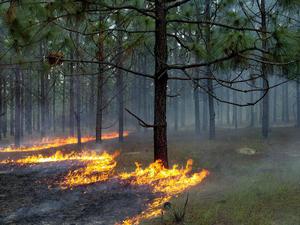Helping You Manage Your Natural Resource Responsibly
Call True North
Mobile: 919-815-3468
Prescribed Burning
Understory Prescribe Fire Coordination
Fire has always been an important part of forest ecology. There are five principal purposes or goals for understory burning:
- Fuel reduction
- Hardwood control
- Site preparation
- Wildlife management
- Disease control
The timing of burning also has a major impact on each of these goals.
First controlled fires conducted during the growing season (spring through summer) can affectively control developing understory hardwood saplings. These hardwoods, if left unchecked can negatively effect pine growth by stealing available moisture and soil nutrients, restricting the development of natural regeneration, restricting visibility and mobility for humans and animals, and making it more difficult to rake pine straw.
Site preparation burns are conducted to eliminate as much competition as possible and reduce the amount of logging slash following a harvest to usually done in the late summer or fall when the fuel is dry so it will reduce the logging debris and burn hot enough to kill developing hardwoods.
Controlled fire is also used to reduce fuel loads in the woods to lessen the devastating effects of a natural wildfire.The build up of understory fuel, especially in pine stands can extremely flammable during dry periods and if not controlled can be quite dangerous. Fuel reduction burns are not usually conducted in stands less than 20 feet and are conducted during the winter in the evenings or at night so that they move slowly with a flame height no higher than 3 feet.
Control burning is also used to control of pine diseases such as brown spot needle blight and annosum root rot. Both brown spot needle blight and annosum root rot can be effectively controlled by running controlled fires in the winter.
Controlled fire can also be an effective wildlife management tool depending on which species or habitat you are trying to create. Generally, fires that control understory growth will promote grasses, forbs, herbs, and wildflowers, which are beneficial for wildlife. Staggering burns and not burning all your woodlands at once will create unburned islands that wildlife can use and relocate to while burned areas recover.
True North Forest Management Services can help you plan and coordinate understory burns on your property to achieve your objectives. Let us design and develop an understory burning plan and work with a Certified Burning Contractor and/or the state forestry agency to get fire lines installed and the understory burnings conducted on your property in a timely manner. Let us help you locate possible cost-share funding to offset the cost of the burn.
"One of the most harmful things modern man has done to birds has been his attempt to exclude fire from fire-type pine forests. Within a few years most forests choke up with brush, lose their prairie-like vegetation, and can no longer support birds dependent on periodic burning for their food supply and proper cover." Herbert Stoddard (1963
True North Forest Management Services
Helping You Manage Your Natural Resource Responsibly

